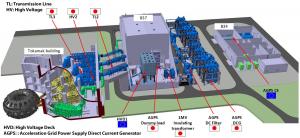Lightning-power voltage
In the European JET, presently the world's largest operating tokamak, the neutral beam system delivers an electrical voltage on the order of 130,000 volts; in the Euro-Japanese JT-60SA, it will reach 500,000 volts for a few minutes; in ITER, it will need to deliver one million volts (1MV) for durations of up to one hour.
The twin halls for the heating neutral beam system will be mostly empty, with the exception of two towering, alien-looking components: the 9-metre tall high-voltage deck sitting on its 6-metre tall insulating supports, as well as the even-taller bushing (16 metres) for the giant insulating transformer whose main body sits outside the building. The nature of these one-of-a-kind electrical powerhouses has imposed severe constraints on the building's interior design. To prevent the generation of electrical arcs, no element inside the halls can present a sharp angle or a protruding structure, and for safety reasons each deck is surrounded by a five-metre-radius "exclusion zone." Needless to say, no one will be admitted inside the building during operation.
Less spectacular but no less strategic, the Neutral Beam Power Supply Building will host the electrical equipment—dry transformers, power convertors, rectifiers, inverters and other exotic devices—that will feed power to the high-voltage decks through the ten step-up transformers installed between the buildings. Like many components in the ITER installation, the neutral beam system operates in DC current. But contrary to the magnets for instance, which demand high current and low voltage, the neutral beam system requires low current and ultra-high voltage.
This difference doesn't make the equipment smaller: procured by Japan, the ten 200 kV DCGs (a step-up transformer connected to a diode tank to obtain 200kV output DC voltage) for the heating neutral beam, each in its own stall separated by thick blast walls, are as large as the giant pulsed power network transformers in the ITER switchyard. Here again, it is the insulation requirements, particularly the quantity of oil that each transformer contains (up to 75,000 litres) that determines the size. Three smaller transformers will be dedicated to the diagnostics neutral beam system.)
Only the raw forces of nature generate voltage higher than that of ITER's neutral beam power supply installation. But lightning strikes are millisecond events, whereas the formidable electrical installation on the ITER site is designed to steadily feed the injectors for hour-long plasma discharges. As such, it has no equivalent in the world.




